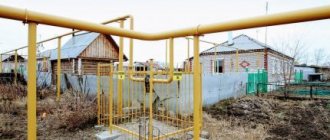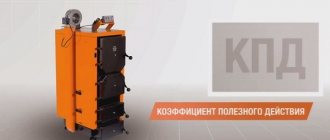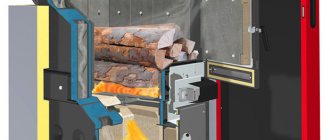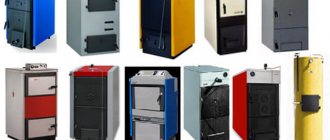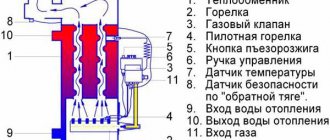Consequences of a clogged heat exchanger
The heat exchanger of a gas boiler is a bent pipe made of metal or cast iron. It is heated by the flame of a gas burner, and then transfers heat to the heat transfer fluid, which moves throughout the heating system. If the heat exchanger is clean, it gives off heat efficiently. When salt deposits accumulate in it, its thermal conductivity decreases. Then the gas boiler has to heat the coolant longer, which entails an increase in fuel and electricity consumption.
In case of severe contamination of the element, in order to maintain the desired temperature, it must be in the maximum heated state for a long time - this leads to overheating of the heat exchanger and its failure.
Deposits and scale also impede the movement of the coolant along the circuit. As a result, the load on the circulation pump increases.
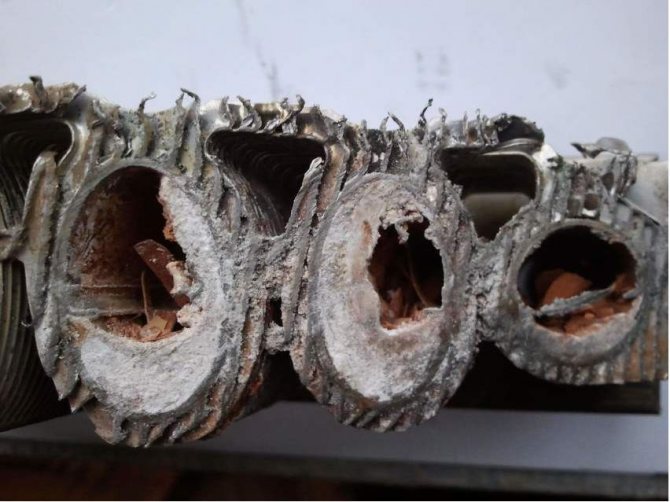
Thus, a contaminated heat exchanger threatens failure not only of the element itself, but also of other important units of the unit. To prevent damage, the boiler should be cleaned regularly.
…
Note! In double-circuit models, the secondary heat exchanger, which works to heat hot water, often fails.
How often should the heat exchanger be cleaned?
The frequency of cleaning the heat exchanger of a gas boiler is usually indicated in the operating instructions. If there is a filter on the water inlet pipe, then cleaning can be done less frequently. If there is no filtration and there is hard water in the region, then the heat exchanger will clog up faster.
Usually, without a water filter, cleaning is done once a year or two. If the tap water is filtered, it is sufficient to take care of the heat exchanger once every 4 years.
Exist signs that urgent circuit cleaning is needed:
- Fuel consumption has increased - with a clogged circuit, gas consumption can increase by 15-20%.
- The performance of the heating system has decreased. Signs of this may be as follows: poor heating of the batteries, the unit cannot reach the required temperature and works continuously.
- Weak water pressure from the DHW system or insufficient heating.
- Noises in the heat exchanger.
- An increased load on the circulation pump is created.
If at least one such "symptom" appears, the heat exchanger should be cleaned as soon as possible, otherwise inaction will lead to costly repairs.
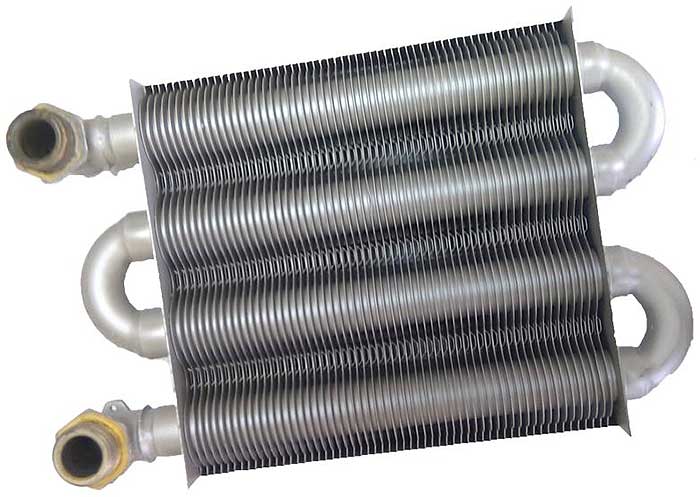

Gas boiler cleaning options
There are several basic methods for cleaning gas boiler heat exchangers:
…
- manual;
- chemical;
- hydrodynamic.
Which method to use depends on the degree of blockage. Let's take a closer look at each of the listed methods.
Manual cleaning
Not all users of gas boilers know how to clean the heat exchanger of a gas boiler themselves. The easiest way to do manual cleaning is to do it yourself. There are two ways to accomplish this method:
- mechanical - with a brush and a brush;
- flushing with active solutions is a more effective option, especially relevant for boilers with two circuits.
In case of stubborn dirt, two methods of descaling are used - first rinsing, and then mechanical cleaning. This process is carried out in the following stages:
- turn off the gas and disconnect the unit from electricity;
- open the lid of the gas boiler;
- dismantle the heat exchanger;
- place it in an active substance, for example, a solution of hydrochloric acid;
- pull the heat exchanger out of the solution and clean the dirt with a brush or brush;
- rinse the element with water outside and inside;
- dry and reinstall the circuit.
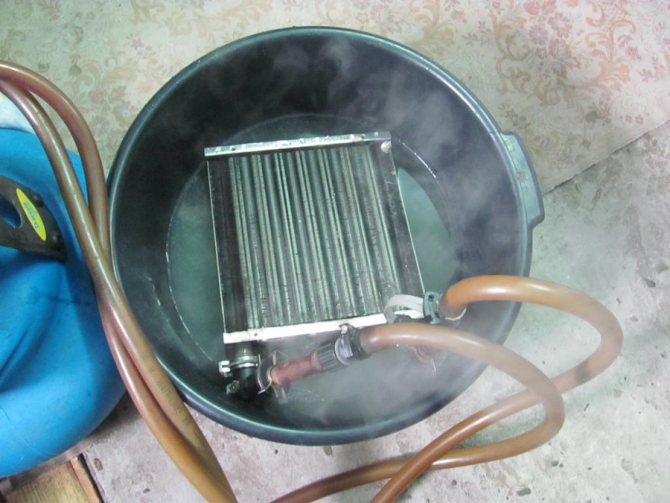

Dry cleaning
Chemical cleaning is characterized by the use of a booster or its analogues, as well as aggressive chemicals. An important condition for chemical cleaning is to maintain a safe concentration of the substance so that it does not corrode the surface of the heat exchanger.
Dry cleaning is carried out using a booster, but many craftsmen create its cheap analogue with their own hands. To do this, take a container of 10 liters and attach two hoses and a pump to it.
Find out here how to change a gas boiler - rules and responsibilities
Maintenance and repair of gas boilers
Replacing the heat exchanger in a gas boiler with your own hands
If the scale layer is too large, you can use a sulfuric or hydrochloric acid-based substance for cleaning. The simplest cleaning solution is made from citric acid: 200 g of powder is diluted with 5 liters of water.
The chemical cleaning process is quite simple:
- the chemical solution is diluted in containers and poured into a booster;
- two hoses are connected to two boiler nozzles - inlet and return;
- turn on the device and run the liquid through the heat exchanger several times.
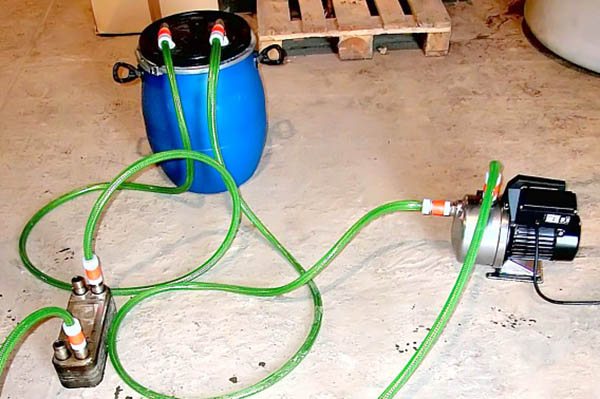

Factory boosters have a heating function, which allows you to flush the circuits with greater efficiency.
After the procedure, it is necessary to drain the reagent and flush the system again with a neutralizing agent or clean water.
Of course, dry cleaning is more effective than manual cleaning, but the active substances contained in solutions can lead to corrosion. Therefore, this method cannot be used often.
Heat exchanger cleaning solutions
Some owners of gas boilers on the forums are interested in how to rinse a gas boiler from scale at home. Usually, the following agents are used for dry cleaning:
- Cleaning gel - This is considered to be the mildest cleaning agent. After that, it is enough to rinse the heat exchanger with running water. Despite the gentle effect, the gel copes well with scale and lime deposits.
- Adipic acid - in order to flush the heat exchanger of a gas boiler with acid, it is important to dilute it with water in the correct proportion, otherwise the substance will damage the metal surface. Adipic acid well softens all deposits inside the heat exchanger. After flushing the system with this agent, the neutralizing liquid should be driven through it.
- Sulfamic acid - good for tough dirt. The substance is diluted with water and filled into a booster. After the completion of the process, it is necessary to flush the heat exchanger with a neutralizing liquid.
Note! When performing dry cleaning, you should wear rubber gloves on your hands, and protect your body with overalls through which the acid solution cannot get on the skin.
Hydrodynamic cleaning
This method of cleaning the heat exchanger is carried out only by specialists. It is unnecessary to disassemble the boiler and remove the heat exchanger for its implementation. The principle of hydrodynamic cleaning is as follows: the liquid is pumped into the system and driven under pressure several times. For greater efficiency, abrasive cleaning agents are added to the water. It turns out that due to the rapid movement of water, scale disappears and contamination is washed off.
However, with this method, it is important to correctly calculate the pressure force - if it is too large, a pipe break may occur. Therefore, hydrodynamic cleaning cannot be performed on your own.
Do I need to conclude a contract for the maintenance of a gas boiler?
How to properly ground a gas boiler? -
https://oteple.com/kak-pravilno-vypolnit-zazemlenie-gazovogo-kotla/
Cleaning and flushing methods
There are two ways to service the heat exchangers of a water heating plant, each of which has its own advantages and disadvantages:
- with disassembly of the unit and removal of the water heater;
- without disassembly.
The first method will cost you less, but you will have to be patient and spend much more time. In addition, a minimum set of tools is required, the composition of which depends on the design of the boiler.
If you need to clean a floor-standing boiler with a fire-tube heat exchanger, then you cannot do without disassembly to remove soot, and you will not be able to completely remove the heat exchanger, you just have to free access to it by removing the gas burner device and the lid with the chimney. How to perform the procedure correctly is shown in the following video.
When it comes to a wall-mounted gas boiler, in order to remove the heat exchanger, you need to disconnect the boiler from the electrical network and take measures to empty both circuits and the expansion tank. If no special fittings are provided for this, then you should shut off the water supply in the house, close the taps on the heating system pipelines and alternately unscrew them from the boiler nozzles, drain the water into the prepared container.
Then the front metal casing and the control panel are unscrewed. The procedure in different models can be performed in different ways, but its essence remains the same - to open access to the heating elements. Next, the secondary heat exchanger for the gas boiler is removed, usually it is attached to the frame with two turnkey bolts - a hexagon. The main heater is more difficult to remove; this will require disassembling the combustion chamber.
The removed elements are best treated from the outside with special agents designed to remove carbon deposits and soot from heat exchangers and chimneys. There is a wide selection of such products on sale, here the choice is entirely yours. Of course, you can use ordinary detergents, but such a solution is irrational, high-quality chemical cleaning of the heat exchanger is preferable. After all, it is not for the same that you spent so much disassembly effort once in 2 or 3 years to wash the heater with kitchen utensil gel.
The inner surfaces, unlike the outer ones, can be rinsed well with a citric acid solution, which is not too aggressive, but it copes well with plaque. If the scale layer is significant, then you will have to make a washing installation. Its task is to ensure the circulation of the cleaning solution through the heat exchanger for several hours. To clean the heat exchanger from scale, use a container of 8-10 liters and a pump with two hoses connected to the heater pipes.
Here you can use a conventional circulation pump for heating systems. Again, in this way, flushing is performed without disassembling the boiler, you just need to connect the hoses to the corresponding
What are the differences between cleaning a double-circuit gas boiler?
How to flush the secondary heat exchanger of a gas boiler with your own hands? There are no fundamental differences between flushing the DHW circuit and the heating heat exchanger. It's just that in the case of a two-circuit model, you will have to clean not one, but two elements.
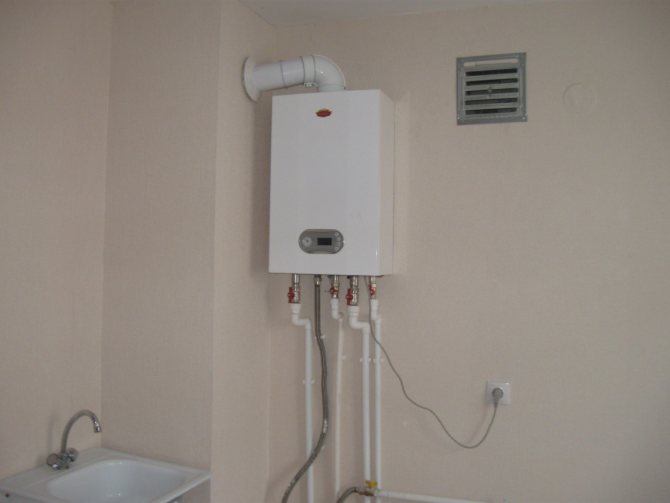

Double-circuit gas boilers can be equipped with two types of heat exchangers:
- removable secondary;
- bithermic.
The first option is cleaned in the same way as the primary circuit using manual or dry cleaning using a booster:
- connect the booster hoses with nozzles for cold water supply and hot water outlet;
- the apparatus is put into operation with heating of the reagent (t = 50-55ºC).
For manual cleaning, the secondary circuit is dismantled and immersed in a citric acid solution. Then brushed outside and dried.
A bithermal heat exchanger consists of two pipes inserted into one another: a coolant moves along one of them, hot water flows along the other.Its cleaning is much more difficult to carry out, especially since such a circuit cannot be dismantled as a separate analogue. Therefore, flushing of the bithermic circuit can only be performed using a booster. If such an element is heavily contaminated, then it is simply impossible to clean it. Then you will have to buy a new bithermal heat exchanger and install it instead of the old one.
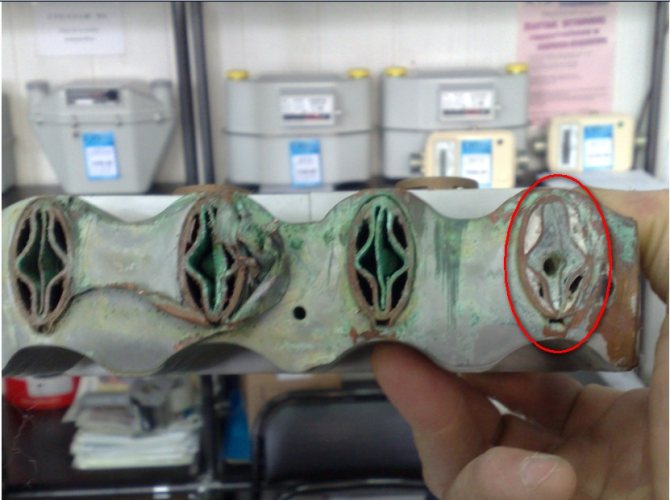

Primary, secondary and bithermic devices
The primary heat exchanger looks like a large tube with serpentine bends. For production, materials are used that are not subject to corrosion - stainless steel, copper. The unit plates are of different sizes. To increase protection against corrosion, the working surfaces are painted. The heat exchanger transfers the energy of the gas to the heat carrier. The power rating depends on the number of fins and the length of the pipe. Dirt and soot on the outside and salt deposits on the inside can impair performance. External and internal factors provoke a violation of the circulation of the coolant and reduce the thermal conductivity of the unit walls. To prolong the life of the boiler, regular cleaning and flushing is required. It is advisable to buy filters.
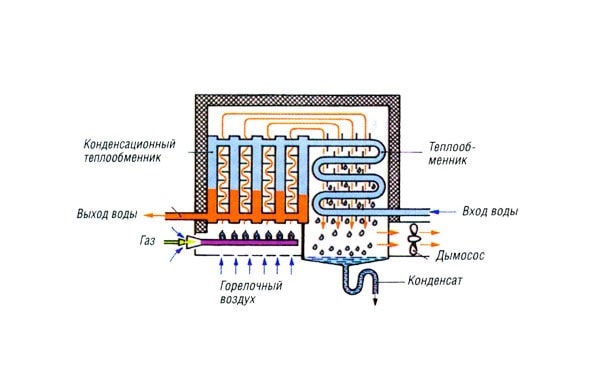

The secondary heat exchanger of the gas boiler is equipped with interconnected stainless steel plates. The efficiency of the device is ensured by good thermal conductivity and the size of the heat exchange section. Energy in such heat exchangers is transferred from the liquid to the heat carrier. The power of the device depends on the number of plates and the heat exchange area.
The bithermal double-circuit heat exchanger works on the principle of double heat exchange: the gas heats the coolant, and it transfers the temperature to the water. Outside, water for heating is heated in the pipe, and water for domestic needs is heated inside. The combined heat exchanger for a double-circuit gas boiler has a simplified design. There is no need to install a three-way valve and a secondary heat exchanger, which reduces the cost of the entire structure without compromising reliability. The disadvantages include low power in hot water supply mode.
The Prime Energy catalog contains units from leading brands. Our heat exchangers are ordered for industrial and municipal systems, and in each case they listen to the recommendations of engineers for the selection of equipment and accessories. The consultants will tell you in detail about the characteristics of the presented heat exchangers, provide comparative data, and, if necessary, calculate the required power and other parameters for a specific object.
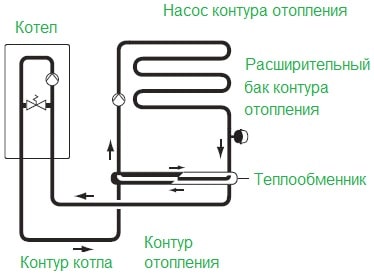

We offer reliable equipment at reasonable prices, we sell heat exchangers of our own assembly, we are the official representatives of Ares, Sondex, FUNKE. It is enough to send an application to receive a calculation or a profitable commercial offer. If you have any questions about the delivery time and the characteristics of the equipment, please contact our specialists.
What is the best way to flush the heat exchanger?
Some people get lost in the variety of contouring substances and often choose the most powerful ones that, with regular use, negatively affect the metal. Experts say that it is better to use such funds as a last resort, if more gentle solutions did not fit. The most versatile remedy is citric acid - it cleans scale no worse than all kinds of expensive products, but at the same time does not damage the surface of the heat exchanger.
If you rinse the circuit in time, and do not wait until the pipes are completely overgrown with salt deposits, then you will not have to use aggressive substances to clean a small layer of scale.
Wall hung boilers with bithermic heat exchanger
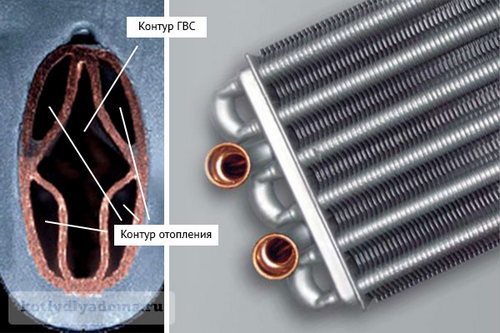

Let's see what a bithermal heat exchanger is. From its name it is clear that we are talking about performing two different tasks within one structure (this is heating water for heating and hot water supply).
For this, a heat exchanger with a special tube design is used. Most often, it is made of copper and has an internal contour resembling an irregular rhombus in the shape of a cut, soldered to the inner surface of the main pipe.
This uncomplicated design allows the internal area to be used for hot water supply, and the external area for heating. Also, for better heat transfer, the outer tube is equipped with plates that provide the greatest contact with the combustion products.
Operating principle
- The plates are heated as a result of fuel combustion and transfer heat to the coolant circulating inside the heating circuit. If hot water is not used for domestic needs, the DHW circuit is shut off.
- When you open a tap with hot water, the heating circuit is blocked and the DHW circuit opens, as a result of which the coolant moving through the inner tube heats up. As soon as the hot water tap is closed, the DHW circuit will automatically close and the flow of the coolant in the heating circuit will resume.
In other words, only one of the two circuits always works, while the DHW water receives heat from the already heated water from the heating circuit. It is believed that boilers with bithermic heat exchangers are 15% cheaper than using separate heat exchangers. But in this case, the efficiency is slightly lower (by about 2%).
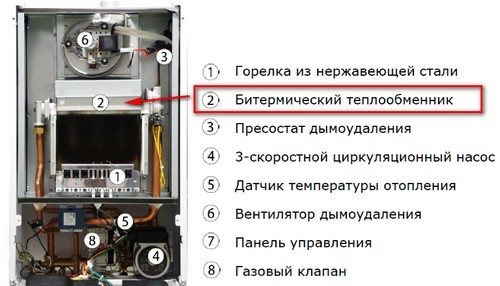

Advantages of boilers with bithermic heat exchangers
- Simple design that does not require the installation of a three-way valve, which often breaks down and needs to be replaced.
- Such boilers have more compact dimensions, since no additional space is required inside the body to accommodate a second heat exchanger.
- Hot water flows directly from the tap during opening, in contrast to using boilers with separate heat exchangers.
- Due to the simpler configuration, many models are cheaper than boilers with an additional heat exchanger.
Some people mistakenly believe that the water from the DHW circuit, located in the inner tube of the heat exchanger, still takes up a significant part of the heat when only heating is required and reduces the overall efficiency of the boiler. Practice shows that this is not the case, and there is no cause for concern.
disadvantages
- Possibility of getting burned while taking a shower. When using a boiler with a bithermal heat exchanger, you need to be more attentive to the temperature of the hot water supply, especially if there are children in the house. This problem is most relevant when there are severe frosts outside and the heating is working at full strength. Having turned on the hot tap, it is better to wait a little until the very hot water drains.
- The duration of the boiler operation in DHW mode has some limitations. This point needs to be clarified with specialists who are well acquainted with the model of a boiler with a bithermal heat exchanger you are purchasing.
- It is undesirable to use a coolant with a high content of impurities, as this will lead to the formation of scale on the inner walls of the heat exchanger tubes. If the water you are using is too hard, it must be softened, which is an additional cost. In our practice, there are cases when the owners of such boilers did not monitor the quality of water in the heating system, and the heat exchanger failed during severe frosts. You yourself understand what serious problems this causes.
- Complicated service. Bithermal heat exchangers are difficult to clean, even if this procedure is entrusted to professionals.
- Due to the clogging of the heat exchanger, the efficiency of the boiler decreases every year.
Sooner or later the moment comes when the bithermal heat exchanger will have to be replaced. Costs can reach 30-40% of the boiler cost. Agree that these are quite large expenses. At the same time, payment for work is not taken into account here.
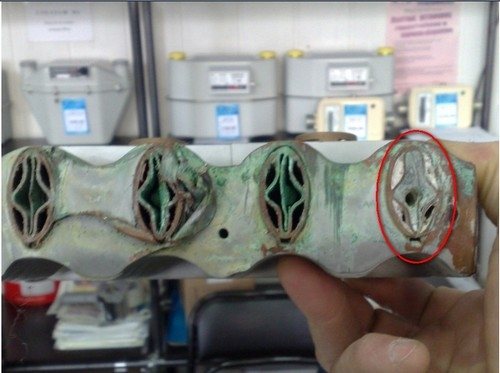

Without any exaggeration, we can say that bithermic heat exchangers are disposable, since cleaning them due to their specific design does not give great results.
We can only recommend the use of such boilers in combination with special cleaning systems that reduce the amount of salts in the coolant.
An example of a boiler with a bithermal heat exchanger is the wall-mounted boiler Baxi Eco Four 24. It has compact dimensions (400x730x299 mm), relatively low weight (29 kg) and is recommended for installation in houses with an area of up to 240 m2.
